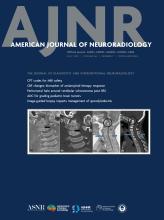Case of the Month
Section Editor: Nicholas Stence, MD
Children's Hospital Colorado, Aurora, CO
June 2016
Next Case of the Month coming July 5 …
Glioblastoma with Postsurgical Pericallosal Pseudoaneurysm
- Diagnosis:
- A 65-year-old man was found to have a large brain mass, which was resected and found to be consistent with glioblastoma.
- Three weeks post-op, patient had worsening neurologic deficits and increased hemorrhage on imaging. CT angiogram revealed pericallosal pseudoaneurysm, which was coiled successfully.
- Background:
- Glioblastoma is the most common primary intracranial brain tumor in adults.
- Prevalence of intracranial aneurysms in the general population is estimated to be 0.2–8.9% of the population.
- Aneurysms occur in approximately 0.5% of patients with brain tumors with ICAs, followed by the MCAs, being the most common sites.
- Clinical Presentation:
- Glioblastomas and intracranial aneurysms can be subdivided into three groups: simultaneous development, glioblastoma development post aneurysm treatment, aneurysm post glioblastoma treatment
- Patients present with symptoms related to intracranial tumor such as headache, confusion, seizure, and neurologic deficit. Less likely, they present with subarachnoid hemorrhage and tumor symptoms, and rarely, isolated subarachnoid hemorrhage.
- Key Diagnostic Features:
- While glioblastomas commonly hemorrhage, these are usually intraparenchymal, with rare extension into the subarachnoid space. The presence of subarachnoid hemorrhage should raise concern for coexisting aneurysm.
- A sudden increase in volume of hemorrhage post-op should raise the concern for development of aneurysm or pseudoaneurysm and rupture.
- Differential Diagnosis:
- Aneurysm development versus iatrogenic pseudoaneurysm formation
- Hemorrhage from residual tumor
- Treatment:
- If the tumor and aneurysm present simultaneously, the lesion causing the most acute symptoms is treated first.
- If the aneurysm is diagnosed post tumor resection, endovascular coiling or surgical clipping of the aneurysm is usually performed.











